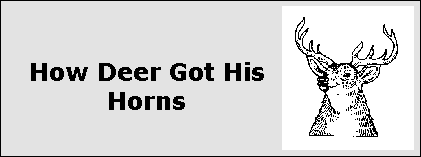

The Deer Clan
Written and researched by Margaret Odrowaz-Sypniewska, B.F.A.

Deer is considered the most important animal ever hunted. Deer tales tell of Deer leading hunters into the woods until they were lost and encountered new adventures. Venison was the favorite from North America to South America. Prayers were said before and after a deer hunt. Deer Clan People were originally from the Onondaga or Cayuga Nations. Deer Clan people are generally timid and kind-hearted. They are quick to form opinions, even though they may not have all the facts. Deer Clan people are somewhat athletic. Deers are extremely sensitive to their surroundings. At the slightest disturbance or wrong smell, their awareness is triggered and with the snap of a twig, they bound off before you know which way they went. Deer Clan people form quick opinions. The Deer can run in bursts up to 45 mph, and jump 8 feet high. Deer people follow rather than lead. Their sensitive nature allows them to hurt easily and many times those around them are baffled as to why. However, no matter how hopeless they might feel, one day they will recover and make things happen. No one knows what Deer might do. Deer is associated with knowledge of pharmacology. They are gentle and sensitive to their surroundings. They are also clever and creative. Three species of Deer are the mule, the white-tailed, and the black-tailed Deer. The white-tailed Deer is the most common in the USA. Bucks develop a large set of antlers. Antlers are solid bone, and Bucks shed them each year. Up until the age of five years, antlers grow bigger and with more points. Fawns are born a color that protects and hides them. Deers stay with their fawns for a prescribed amount of time. Deer teaches us about strong, healthy connections with our children. After a few days a fawn can stand and follows its mother around. Doe fawns stay with their mothers for about a year. The male fawns usually leaves his mother after a few months. The Buck plays no part in raising their young. A Deer's senses are acute. It's vision is designed for clarity at a distance. Its hearing is acute as well. Deer, like Bear, was observed by Medicine men. The Stag (male) is considered a symbol of regeneration, because it renews its antlers. The horned Deer is also linked with the Tree of Life because its antlers are similar in appearance to its branches.
I feel very close to Deer, because they are another one of my grandmother's clans. Deer has appeared to me with messages in the day and at night (via dreams).

When the world was young, Bucks (male deer) didn't have any horns. His head was like that of a doe. Deers are known for their speed and often jump and run off at the first sign of danger. Rabbit was a good jumper and runner too. One day the forest animals decided to have a race between Deer and Rabbit. Beaver carved out a pair of antlers from wood, which would be the winner's prize. However, Rabbit used trickery before the race. He complained to the others that he didn't know the area very well and asked to have a chance to explore the woods before the race. Rabbit was gone for a very long time, so the other animals began to search for him, thinking perhaps he had come to some harm. They finally found Rabbit making a secret trail for himself, one that was too small for Deer to use. The Council of Animals decided that the race was forfeit because of Rabbit's cheating ways. The Deer was awarded the antlers, which allowed him to protect himself. And that is how all Bucks have antlers today.
This page was last updated on March 4, 2006
